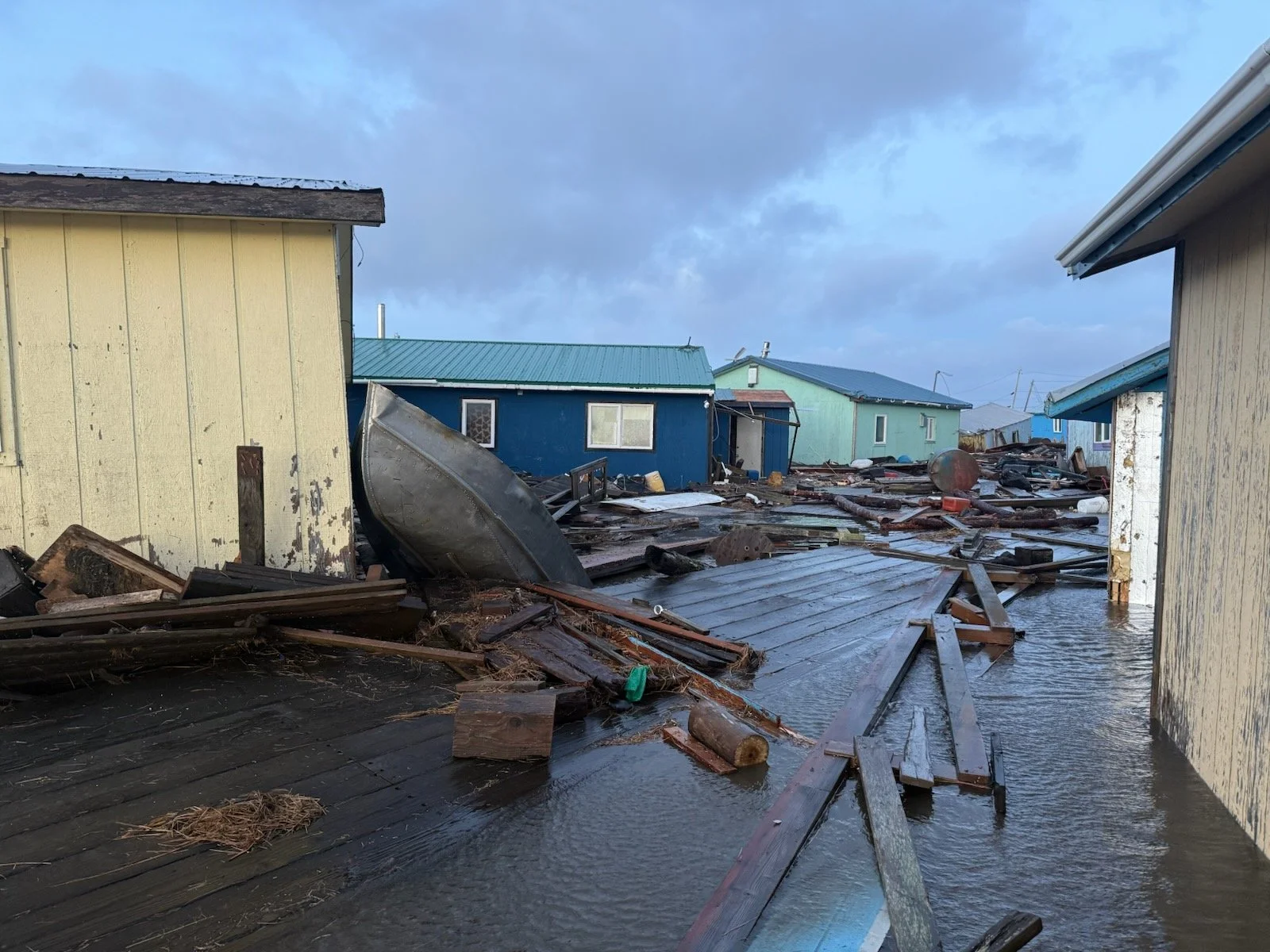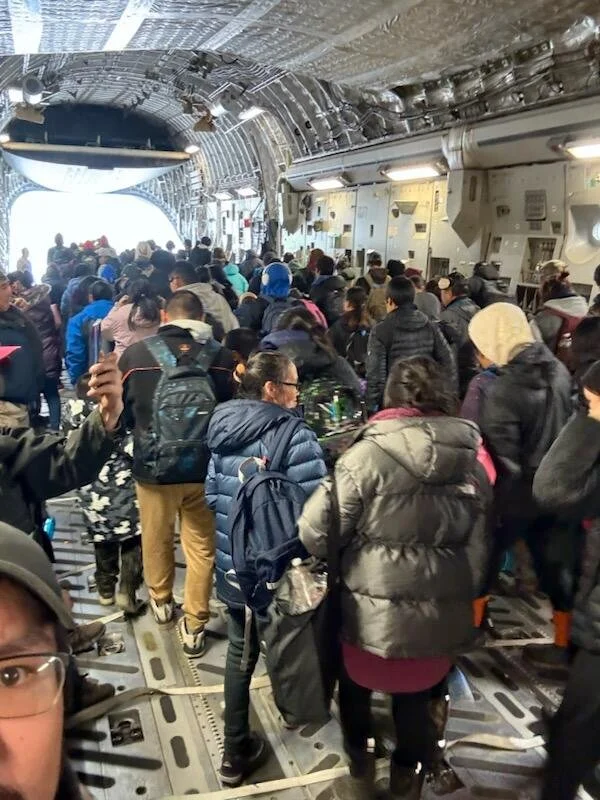Refugees from ex-typhoon Halong find shelter in Fairbanks
By Amber McCain
Photo courtesy of Patrick Andrew
Residents from Kipnuk wait to be evacuated to the school the morning after the strong wind event and flooding that made up to 90% of Kipnuk uninhabitable.
Ex-typhoon Halong tore through the Yukon–Kuskokwim Delta’s villages last week, leaving widespread destruction in its wake.
Jaimee Mesak evacuated from Kipnuk to North Pole with her children and extended family, 5 adults and 6 children in total, described the terrifying speed of the flooding.
“No water on the ground to five feet of water in just minutes,” she said. “We’ve had fall storms before, but it never reached our stairs like that. This time it was halfway up.”
With no time to prepare their escape, her family was allowed only one bag each for the evacuation flight.
“People were grabbing their grass baskets made by their grandmothers. We just needed to be together,” Mesak said.
Patrick Andrew, also from Kipnuk, is a local search and rescue volunteer. Andrew described watching the water and wind shift as the tide rolled in.
“I yelled at my family, ‘Right now!’ We grabbed what we could and were out the door in ten minutes.” His home was later found shattered and floating downriver.
“Everything I worked for, gone. I wore the same clothes for a week,” Andrew said.
Entire homes floated away. In Kipnuk, up to 90% of the housing may be uninhabitable. In neighboring Kwigillingok, houses were washed away, some with families still inside.
Photo courtesy of Patrick Andrew
Andrew, far left, and his family on the evacuation flight to Bethel from Kipnuk.
One person has been confirmed dead, and at least two others remain missing. Over 1,500 people were forced to evacuate with Alaska National Guard calling it the largest airlift in the state’s recent history.
Schools quickly became makeshift shelters, though many lacked basic services. Electricity was spotty, outlets didn’t work, and clean water was limited.
In the midst of all this, UAF student Martin Hope shared what little information he could from his family and friends back home.
“I feel like it just hits harder when you're from a village,” Hope said. “When you're from a village, you know everybody. It's a really tight-knit community. And these houses, they home 10 to 15 people. Most of them, they built them themselves.”
Unfortunately, many remote western Alaska villages rely on aging infrastructure with limited internet and radio coverage, hindering timely storm warnings. The fast onset of typhoon Halong left communities with little time to prepare or evacuate.
Support has not recently been forthcoming.
In May 2025, the EPA canceled a $20 million flood protection grant for Kipnuk, an Alaska Native village, citing that it was “no longer consistent” with agency priorities. The grant aimed to stabilize riverbanks to reduce flooding risks, but the administration attributed the cut to eliminating “wasteful DEI and Environmental Justice grants.” This decision is concerning for the future of vulnerable rural and Indigenous communities already facing increasing climate threats.
However, the Trump administration stands by their decision.
Photo courtesy of Patrick Andrew
Residents board a military transport plane.
“To be brutally candid, due to the proactive cancellation of this grant, $20 million of hardworking U.S. tax dollars are currently sitting in the U.S. treasury instead of swept into the Kuskokwim River,” EPA press secretary Brigit Hirsch said.
On Oct. 16, Bryan Fisher, Director at Alaska’s Division of Homeland Security & Emergency Management, gave a public briefing alongside Brig. Gen. Brian Kile of the Alaska National Guard at which they said the scope of the disaster is hard to overstate. Officials described the damage as among the worst in the state’s recent history, calling it “a combination of all three” previous large-scale disasters, including the 2013 Galena floods and Typhoon Merbok in 2022 and Typhoon Am.
Military and emergency crews had been operating non-stop for more than a week. Over 120 military personnel were deployed. In total, more than 1,500 people have been evacuated from the hardest-hit villages, including over 600 flown to Bethel and Anchorage by helicopter and military aircraft.
“That night was the hardest,” Andrew said. “People were calling saying they were trapped or drifting. We couldn’t reach everyone, it was helpless.”
Photo from Patrick Andrew
Andrew said “My boat is under all of these boats,” in an interview on October 19, 2025. The flooding occurred on October 12.
Officials were clear: many people will not be able to return home this winter. Some communities are simply no longer livable, not just because of damage to homes, but because essential services like water, power, and sanitation have been wiped out.
In Bethel, where storm damage was limited, schools have become safe havens.
“We just enrolled 35 children from Kipnuk, that’s a 20% population increase in a week,” said Hugh Dyment, a UAF advisor and school board member for the Lower Kuskokwim School District. “More are coming. Teachers will be moved here too, but there’s no housing for them yet.”
Dyment explained that local families, including UAF staff, are taking in displaced relatives.
The Kuskokwim Campus is serving as the base of operations for Alaska’s Department of Transportation as they survey infrastructure damage in affected communities. The campus also hosts a UAA nursing program, and faculty and students have volunteered at the local National Guard Armory, assisting evacuees in Bethel prior to transportation to Anchorage.
“The people of Kipnuk and Kwigillingok are adaptable and strong,” he said.
Alaska’s state government is rolling out emergency cash assistance programs for temporary housing, home repairs, funeral costs, and other urgent needs. Residents in the affected areas are encouraged to register for assistance through the State of Alaska Individual Assistance Program. State agencies are working to transition evacuees out of shelters and into individual housing as quickly as possible. Still, some families may be away from home for months, possibly even longer.
Photo courtesy of Patrick Andrew
The blue house was the home of Patrick Andrew and his family before the flooding occurred.
“Recent storms in the Bering Sea are behaving differently,” said Rick Thoman, a climate specialist at the University of Alaska Fairbanks with over 40 years of experience in Alaska and the Arctic. “There’s mounting evidence that Arctic warming and shifts in the jet stream are steering more intense systems farther North than ever before.”
“Ex-Halong tracked exactly across this incredible heat blob,” Thoman said. “That warm water added moisture and energy to the storm, strengthening it significantly.”
“We have to do it all,” Thoman emphasized.
This includes short-term emergency response like evacuations, and long-term adaptation efforts such as building seawalls and relocating entire villages. Mid-term rebuilding strategies, including elevated housing and infrastructure improvements, will be essential to help communities withstand future storms.
Photo courtesy of Patrick Andrew
This was remained of Andrew’s house after the storm. The above photo was the before.
Governor Mike Dunleavy formally requested a major disaster declaration from President Donald J. Trump on Oct.16. In his letter, he stated the extensive damage from several storms since October 8, which have impacted more than 50 remote communities, mostly Alaska Native. If granted, the declaration would provide access to federal resources such as funding, supplies, and assistance from FEMA.
But Dyment was frank about the scale of what lies ahead.
“It took decades and $130 million just to relocate the smaller village of Newtok. It costs over half a million dollars to build a home in rural Alaska and tens of millions for a school. Rebuilding entire communities is not a small ask.”
Brian Fisher, Director, Division of Homeland Security & Emergency Management emphasized that even with federal involvement, the recovery will be led locally, “by the communities, not by Washington.”
That local response has extended beyond people. As families were forced to flee without their pets, rescue groups across the state have stepped up to help. Best Friends Animal Rescue has begun coordinating emergency foster homes for displaced animals.
“We’re accepting fosters not only in our usual areas, Anchorage, the Mat-Su, and Fairbanks, but from surrounding communities as well,” the organization posted.
Meanwhile, survivors like Patrick Andrew are trying to hold onto what they can, including cultural and spiritual lifelines.
“I had seal oil in my moose soup yesterday,” Andrew said. “A taste of home. That made me happy.”
Photo courtesy of Patrick Andrew
The flooding occurred early in the morning on October 12. “We left Kipnuk on October 15 to Bethel,” Andrew said. On October 16, Andrew and his family flew to Anchorage and then to Fairbanks on the 17th.
The storm's impacts have deeply touched the University of Alaska community. In a message to students and staff, Interim Chancellor Mike Sfraga reminded others to be flexible and compassionate, especially for those directly affected.
“Many of our students, colleagues, alumni, and friends have been hit hard by these storms and will need support as they recover,” he wrote.
Sfraga encouraged UAF faculty to be flexible with assignments and deadlines. He shared resources for students navigating emergencies, to include academic advising, counseling, and emergency aid. UAF employees were advised to contact supervisors for time off and utilize the university’s Employee Assistance Program.
He also shared donation links to the Red Cross of Alaska, Alaska Community Foundation, and the Salvation Army’s storm recovery efforts.
“We’re boxing up supplies to mail out, driving a U-Haul to Anchorage, and setting up a free store at the First Church of the Nazarene,” said Allison Lennon, a Thrivalaska employee handling organization efforts.
“Doyon is helping wash and fold donated clothing, and we’re accepting clothes, food, baby items, whatever people can give.” She added that diapers, especially sizes 5 and 6, are in particularly high demand.
For Jaimee Mesak, it comes down to family. “We have everything we need right now,” she said. “We have a warm place to sleep. We just need each other.”








